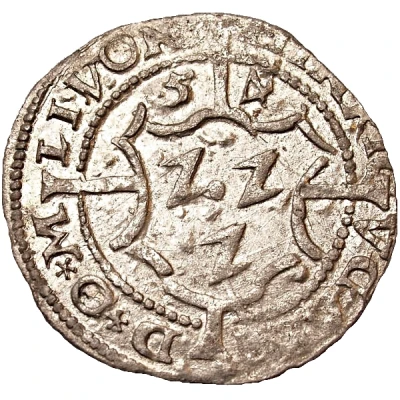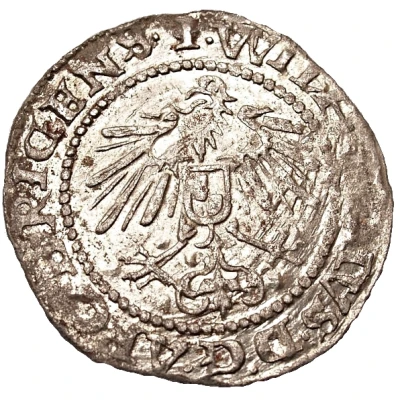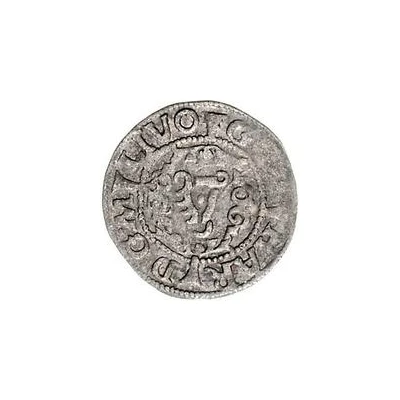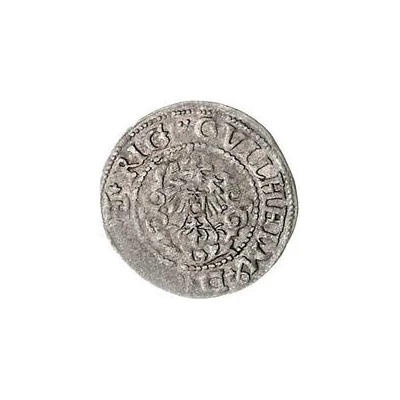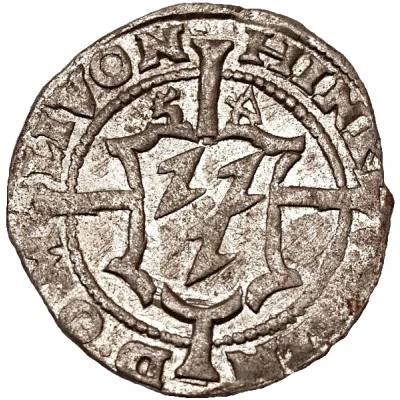
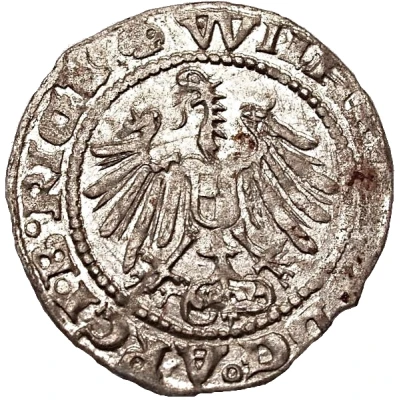

© Haljak Coin Auction
1 Schilling - Heinrich von Galen and Wilhelm von Brandenburg Riga; bumpy top with long sides
| Billon (.1875 silver) | 1.05 g | 18 mm |
| Issuer | Livonia and Riga (Livonian Confederation) |
|---|---|
| Master | Henry of Galen (Heinrich von Galen) (1551-1557) |
| Archbishop | Wilhelm von Brandenburg (1539-1563) |
| Type | Standard circulation coin |
| Years | 1554-1555 (1554-1556) |
| Value | 1 Schilling |
| Currency | Schilling (1500-1561) |
| Composition | Billon (.1875 silver) |
| Weight | 1.05 g |
| Diameter | 18 mm |
| Thickness | 0.7 mm |
| Shape | Round (irregular) |
| Technique | Hammered |
| Orientation | Variable alignment ↺ |
| Demonetized | Yes |
| Updated | 2024-10-06 |
| Numista | N#141866 |
|---|---|
| Rarity index | 100% |
Reverse
Eagle surrounded by legend.
Script: Latin
Lettering: WILHELMVS · D · G · ARC · B · RIGENS ·
Translation:
Wilhelm Dei Gratia Archi Rigensis
Wilhelm, with God's grace, Arch(-bishop) of Riga
Edge
Plain
Comment
This coin was issued as a joint coinage between the Livonian Order and the Archbishopric of Riga.The exact lettering of the surrounding legend may vary.
No date (obverse legend starts at 12:00):
1) HIN - V . GA - D · O · M - LIVO - / WILHELM · D · G · ARC · RIG ·
No date (obverse legend starts at 6:00):
1) HIN - V . GA - D · O · M - LIVO - / WILHELM · D · G · AR · B · RIG ·
No date (obverse legend starts at 9:00):
1) HIN - V . GA - D · O · M - LIVO - / WILHELM · D · G · AR · B · RIGE ·
1554 (retrograde 4; date above the obverse shield):
1) HINRI - V . GALN - D · O · M - LIVON - / WILHELMVS · D · G · ARCI · B · RIGE ·
2) HINRI - V . GALN - D · O · M - LIVON - / WILHELMVS · D · G · ARC · B · RIGENS ·
1554 (date divided by obverse shield):
1) HINR - V . GALN - D · O · M - LIVON - / WILHELM · D · G · AR · B · RIGENSIS ·
2) HINR - V . GA - D · O · M - LIVO - / WILHELM · D · G · ARC · B · RIG ·
Interesting fact
One interesting fact about this coin is that it was minted during a time of great turmoil in the region. The Livonian Confederation was a loose alliance of territories in present-day Estonia and Latvia that was formed in 1418, and it struggled to maintain its independence against the neighboring powers of Lithuania, Poland, and Russia. The coin was minted during a period of political upheaval, with the Archbishop of Riga, Heinrich von Galen, and the Master of the Teutonic Order, Wilhelm von Brandenburg, both vying for control of the region. Despite these challenges, the coin remained in circulation for several years, a testament to the resilience of the people of Livonia and Riga.
